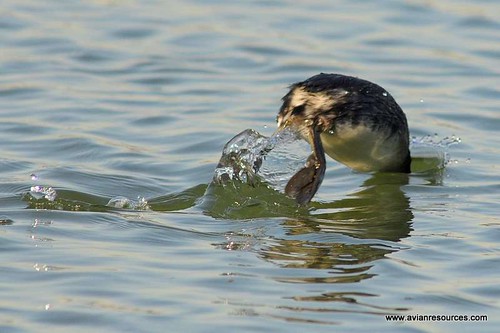tags: Eared Diver, Black-necked Grebe, Eared Grebe, Podiceps nigricollis, birds, mystery bird, bird ID quiz
[Mystery bird] Eared Grebe, also known as the Black-necked Grebe or the Eared Diver, Podiceps nigricollis, photographed in California. [I will identify this bird for you in 48 hours]
Image: Steve Duncan [larger view].
Nikon D200 w/ Nikkor 300mm f/4 & TC17E.
Please name at least one field mark that supports your identification.


With the big feet positioned at the far end of the body I'm going to guess pied-billed grebe.
Hey, Grrl, the larger image link goes back to yesterday's bird.
JPS -- with lobed feet and a white belly, this bird is definitely a grebe. It appears that the white on the underside extends too far onto the neck for a Pied-billed, but I'm not sure I can take it beyond that. I'm left with Red-necked, Horned, and Eared. (I think Western and Clark's would be much more contrasty. This bird also seems too compact for Western/Clark's.)
Of course, the date the photo was shot could help.
My first thought on seeing the photo was "Eared Grebe". I haven't checked Sibley, though.
I can't decide between Horned and Eared. They seemed to be the best matches on colour - particularly the white underside. I don't know how to narrow it further, though.
Paul, I get the impression that this is a smaller bird than Western, Clark's, or Red-necked...
There seems to be virtually nothing to choose from between the Eared and the Horned except perhaps the impression of the flank coloring- on most of the ID comparisons between the two species, most of the indicators cannot be seen here: cheeks, tip of the bill, shape of head, arch of back, however they all describe the Eared as having relatively gray flanks whereas the Horned has either white or streaked- so in this case, I will have to gamble with an Eared...
I'm with SimonG on this one, it's either Slavonian or Black-necked Grebe (just to confuse things). Just to be more perverse I'm going with "auritus".
ahh, then I will attempt to clarify why the "Eared" Grebe... technically it is indeed the Black-necked Grebe, Podiceps nigricollis, but I understand that the californicus subspecies (as opposed to the Euasian nominate nigricollis and the southern African gurneyi) is called the Eared... so Adrian, you are going with the Horned!
David -- I got that size impression as well. In fact, my first thought was Pied-billed. I'm just not sure I can see anything that confirms that impression. I certainly can't see anything to rule out either species.
Hey Paul,
These are the closest comparisons I can find for the Pied-billed- the photo does not show the entire underside but I get the impression that it is less white looking as we see above...
the drawing of the non-breeding flyer (top left) seems to show that we would expect to see an obvious buffy area towards the rear of the belly...
Pied-billed Grebe on "take-off"
drawings of Pied-billed Grebe from the Sibley Guide to Birds of Western North America
psweet: i fixed that link. sorry about that!
anyway, i don't have the precise date for this image, but it was snapped in the winter.
i keep getting stuck trying to decide between eared and horned grebes, which is why i posted this image here, to hopefully learn how to distinguish between the two from this angle.
Hey Grrl, slight technical problem on the Anna's Hummingbird post: all your description and everyone's comments have been scored through! Guess it really was another Chipping Sparrow after all!
I've just gone through my photo's of Eared on the Salton Sea in November and cannot see much difference in flank colour between these and my photo's of Horned taken in GB in winter. So I'm still uncertain which species this is.
Adrian,
One aspect of the bird above that has troubled me has been the black chest- in all "conventional" photos and descriptions of both the Horned and Eared Grebes, I read and see that the neck and chest tends to be white, but not so above...
I did find one source from Bert Frenze, an ornithologist who has specialized in Texas birds for some time, where he notes in his "Decision Tree for Identifying Grebes [in Brazos Bend, Texas] that Eared Grebes tend to have a darker neck in winter as compared to Horned Grebes...
a further interesting piece of research on leucism in Eared Grebes shows that some color forms do indeed have white underneath with dark backs and a black head, neck, and black chest (Table 1, Category 5) and although I am not suggesting that this particular individual is leucistic, because leucism does indeed range from almost undetectable to totally white across the pigment spectrum, I would not be surprised (given the dark neck above) if this bird was very close to the "category" noted above... perhaps Grrl can try to get Steve Duncan to supply us with a profile shot of the same individual for comparison?
Given the relatively gray (as opposed to white or streaked) flanks and the dark neck, I am still tending towards Eared (Black-necked) as opposed to Horned (Slavonian)
One more complicating factor on this bird. Horned and Eared Grebes have rather prolonged spring molts. And since both of them have dark necks during the summer, not knowing the actual date of the shot makes this that much more difficult.
Good point Paul, I guess I was lured into assuming this was a definite winter plumage- Jan/Feb in California...